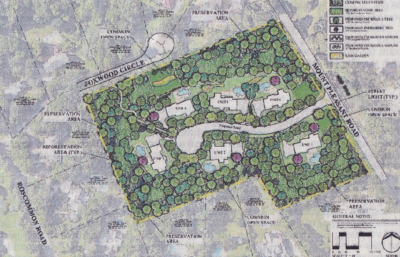
The proposed development is according to code and the open space is commendable, but the municipality’s refusal to accept the street could sink this plan.
The process of presenting a residential development to a local governing body doesn’t often follow a smooth trajectory from proposal to approval. Sometimes even when it does seem to be on a sure course toward success, odd things can pop up to throw the developer off track.
The image accompanying this article depicts a proposal to tear down one unremarkable 1970s house and build six new homes on a two-lot site not far from my part of the same township. The preliminary plans looked good to the planning commission, especially with the open space preserved in the layout schematic. But there is one hitch: the developer wants the cul-de-sac road to be public while the township wants it to be private. There are big outcome consequences to both sides in trying to resolve the current impasse.
It is a well-known and long-established bit of real property legal lore that ownership of property runs to the centerline of abutting streets unless there is specific language to the contrary in the conveyancing documents. That is true whether a street is public or private. Then matters get a little more complex.
When the street is public, ownership still extends to the center of the street (assuming title runs that way) but it is subject to an easement for the public to use the road. And if a street is public, then not only does the public at large have the right to use it (whether the public uses it or not) but there is also a public (governmental) responsibility to maintain the road.
When a street is private, then ownership extends to wherever the title extends and there is no public right to use the street except as agreed and allowed by the owners. And maintenance is the responsibility of those private owners.
What are the implications for each side of the current situation? If the road is public, then the municipality is charged with paving, trash and snow removal, and signage. If the road is private, then the owners must fulfill and pay for these services. They will also need to negotiate with utilities as to where facilities are to be installed and then pay for the installations. Forming a homeowner’s association is the usual approach to these kinds of shared responsibilities. Do they agree to share the expense of maintaining a main water line in the street with connecting laterals to be at private cost? Will they form a snow shoveling brigade or hire someone to clear the street? Should they contract with the municipality for trash removal or hire a private firm? How do they make sure everyone pays their fair share of costs? It isn’t as though non-paying owners could easily be prohibited from using the road.
The developer’s plan calls for the road to be built to municipal public street standards. But dead end streets are notoriously difficult creatures. Most notably, they make emergency access more difficult due to having only one way in and out, with limited turnaround space. While that point supports the municipality’s refusal to accept the road, the developer’s unanswered question was whether all cul-de-sacs in the municipality should be made private. I can see that translating to a claim of unequal treatment under the law and opening the possibility of litigation.
The concept of “offer and acceptance” for the dedication of roads sometimes gets sticky when we surveyors look at recorded subdivision plans that show streets. Mere depiction of a platted road generally does not mean that it has been formally dedicated (unless jurisdictional law says it does). Not only must there be an offer, but there must be an acceptance on the part of the entity on which the responsibility is to be bestowed. So merely showing this developer’s proposed dead end street on a recorded map is not an option.
On the other hand, once an offer is made and actions by the intended recipient indicate acceptance, whether a deed is filed or not, dedication has occurred. A 2019 case (Prout v. Dept. of Transportation, Docket Number C076812) addressed such a situation, in which landowner Loren Prout lost his claim of inverse condemnation against the California Department of Transportation (Caltrans) for its use of a strip of land along a state highway without compensating him. The Court of Appeals pointed out that Prout had obtained an encroachment permit for his development in exchange for an agreement to dedicate the now-disputed strip to Caltrans.
Prout had, in fact, shown this area on his subdivision map as “In the Process of Being Deeded to Caltrans For Highway Purposes” to comply with the permit requirements—but no deed was ever signed or recorded. Caltrans eventually acted on the platted offer of dedication by physically occupying the strip for highway improvements (the time it took between platted “offer” and Caltrans’ action was one of Prout’s arguments against dedication). The combination of Prout’s platted offer to dedicate with actions by Caltrans that amounted to “implied acceptance” (as opposed to “express acceptance” in a recorded document) convinced both the lower and upper courts to prevent revocation of the offer. The moral of that story Is that getting both sides of the dedication transaction committed to writing – and in the public record—keeps things clear and out of court.